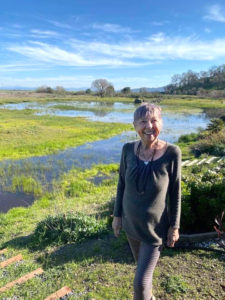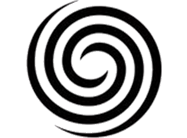Marianne Gontarz York
April 7, 1948— May 1, 2022
Below is a summary of Marianne’s Biography Night talk, remembrances, her journey with cancer, and excerpts from her article in the Echo.
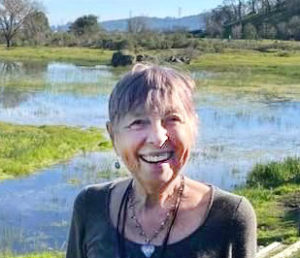
Marianne York
Excerpts of her Biography Night talk from the
June 2022 Echo
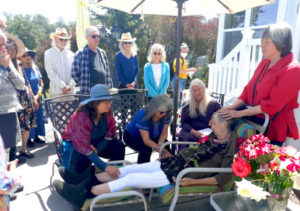
Remembrances of 5-1-22
by
Aneesha Dillon
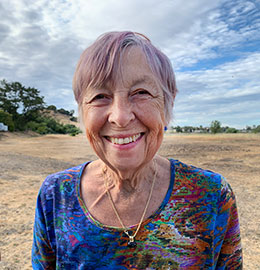
My Cancer Journey (or Living and Dying with Cancer)
by Marianne York
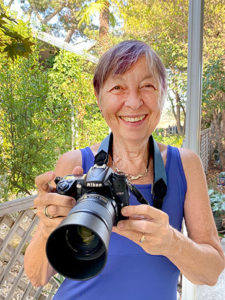
Marianne Gontarz York
Interview
November 220 Echo
Our dear Marianne took the end-of-life medicine at 1 pm on Sunday, May 1. She died peacefully on her beloved patio, surrounded by loved ones including her Marin Valley family. Lorna Sass excerpted the following thoughts from Marianne’s zoom talk in our Bio Nights. You can see her complete talk at our Marin Valley YouTube channel (https://youtu.be/RC07D8Ft1_0).
I moved into MVMCC in 2013 with my husband, Mike York. After we sold our home in Terra Linda, we happened upon MVMCC and both thanked our lucky stars. What an amazing community this is!
Mike died suddenly on March 1, 2018, nearly four years ago.
I — a lifetime professional caregiver and gerontologist — was literally shattered by his loss. I wanted to die. Mike had been the one reliable source of love in my life. However, much to my amazement, this community (among others I wasn’t even aware of) poured so much love into me that instead of contracting into grief, I began to open to love around me.
I am reminded of a line in the beautiful Leonard Cohen song Anthem: ‘There is a crack in everything; that’s how the light gets in.’
Learning to receive love was the ultimate gift of Mike’s death. I really started to see and feel that love was everywhere, but especially in this community. I also did grief work and took a year-long class at Spirit Rock called One Year to Live, inspired by Stephen Levine’s book of that title.
One year and nine months after Mike’s death, I was diagnosed with a very serious form of cancer: stage 4 metastatic colon cancer.
I was just getting a foothold on a new life. I had met David Goings, a recent widower, 7 months before. We both went to a workshop to get hugs and we became grief buddies.
Across 3,000 miles and despite COVID, we developed an authentic, loving relationship … to this day. It looked like I had a new lease on life; I was going to travel and take photos, which has long been a great passion of mine.
Not so fast … It became clear early on to everyone but me that I wasn’t a candidate for surgery because my tumor was barely shrinking. Over the following months, I realized that learning to live with cancer was the best I was going to get.
Cancer thrust me into living in the moment like never before. I joined a Zoom Healing Circle for people living with cancer via Commonweal Institute in Bolinas.
Last Thanksgiving, I received news of a very abnormal scan. Thankfully, my stepdaughter Keri was with me. After my meltdown, I told her that the two good things that would come of this are that the cancer journey would be over and that her father Mike would be on the other side to greet me.
Death is one of the most powerful transitions and yet most everyone denies it. It’s the ultimate transformation.…
I plan on living full out as long as I can, and to love every moment of life, to accept love and to learn how to be loved. I plan to end my life in a crescendo!

Marianne’s Farewell
May 1, 2022
by Aneesha Dillon
Marianne’s Farewell
It was a warm sunny day, and the greenery in the Meadow in front of Marianne York’s lovely Bay-view home was ruffling in the gentle breeze. The swallows and the red-wing blackbirds, caught up in their dances and songs, unknowingly provided the soundscape that would soon accompany Marianne’s departure on the next leg of her life journey. Because this day, May 1, was the day Marianne decided to exercise her legal right to use medical aid in dying. And she wanted to do it on her beloved, beautiful deck, facing the Bay.
Having received a diagnosis more than two years ago, she had been treating her inoperable, incurable cancer with both allopathic and natural medicines, and she maintained a high level of energy and quality of life until recent months. Always one to forge her own direction in life, Marianne took the bold decision that, if her illness became too painful, and if her quality of life felt no longer viable, she was clear that she would accept medical aid in dying. She arranged it with her doctor.
(California legalized the process in 2016, and although in the beginning, it was somewhat cumbersome and lengthy, the procedure has now become much more streamlined and accessible. More information is available in the Circle of Friends page on the Marin Valley website, and through Compassion and Choices.)
On Saturday, April 30th, Marianne had been feeling very sick and uncomfortable, and that night she suddenly decided that Sunday would be the day. She was given some morphine by the hospice nurse to help her sleep comfortably that night. Her beloved step-daughter Kari was visiting and lovingly caring for her.
At around 9 am on Sunday a few of us arrived at Marianne’s home to help her prepare for her journey, finishing loose ends and making final phone calls. The life-ending medicine had been delivered some weeks before, and everything was ready. Marianne had spent the last year finishing all her unfinished business, clearing out papers, sorting photos, and giving away her belongings. She was an acclaimed photographer and had completed an extensive legacy project. She was ready…
At 1:00 pm about six people sat with Marianne on her deck as she swallowed the medicine—approx. ¼ cup of powder mixed with juice—and by the look on her face it clearly tasted horrible! Even though she had taken anti-nausea medication, it was hard to keep it all down. After a short time Marianne seemed to fall asleep and her breathing slowed….and stopped. The nurse let us know when her pulse was gone.
On the deck next door, another 20-25 friends and neighbors had gathered to support Marianne in silent meditation as she left her body. Then they all came over, and a poem was read, some gentle songs were sung, and flowers placed. It was a simple, sacred, heartful departure and all felt touched.

My Cancer Journey
(Or Living and Dying
with Cancer)
by Marianne Gontarz York
My Cancer Journey (Or Living and Dying with Cancer)
By Marianne Gontarz York
Death is a taboo topic and raising it and demystifying it is not for the faint-hearted.
Gratitudes
**I would like to begin by thanking Aneesha Dillon for starting her groups in Marin Valley to study death and dying. These group discussions helped raise the consciousness in our community about death and dying.
**I so appreciate Michael Hagerty for moving this process forward with the formation of the weekly Sunday meditation group. Holding sacred space to support people going through the process of illness has nurtured and sustained me. As I am sure it did Terry Patten and Sagar ____, recently deceased.
**To all of you beloved friends and neighbors for jumping in and wanted to explore death … thank you.
**Special thanks to Timo Navsky and Aneesha Dillon for wanting to keep this consciousness alive and well in the community going forward
**David Goings, who stands by my side and supports me. His presence in my life is still a great mystery to me.
My Cancer Journey and What I Learned Along the Way
To start at the beginning …
I moved into MVMCC in 2013 with my husband, Mike York.
After we sold our home in Terra Linda we happened upon MVMCC and we both thanked our lucky stars we did. What an amazing community this is!
Some of you know that Mike died suddenly on March 1, 2018–nearly four years ago.
I, a lifetime professional caregiver and gerontologist, was literally shattered by his loss. I wanted to die. Mike had been the one reliable source of love in my life.
However, much to my amazement, this community (among others I wasn’t even aware of) poured love into me so instead of contracting into grief, I began to open to love around me.
I am reminded of a line in the beautiful Leonard Cohen song, Anthem: “There is a crack in everything; that’s how the light gets in.”
Learning to receive love was the ultimate gift of his death. I really started to see and feel that love was everywhere. But I really felt it here in this comunity. I also did grief work and took a year-long class at Spirit Rock called One Year to Live, inspired by Stephen Levine’s book of that title.
I recently read in Bernie Siegel’s Love, Medicine, Miracles, which points out that stress can be measured and the highest value of 100 is attached to the death of a spouse — and that this most traumatic of events is often followed by cancer or other catastrophic illness in 1-2 years.
And, as luck would have it, one year and nine months after Mike’s death, I was diagnosed with a very serious form of cancer: stage 4 metastatic, colon cancer. I went to the ER November 10, 2019 because I was feeling nausea and severe abdominal pain. I thought it was a pull resulting from a challenging Pilates workout.
Before this episode, I had never been sick. My parents died at 89 and 92 so I had good genes. My body had always worked well, and I was taking good care of it.
Also, I was just getting a foothold on a new life. I had met David Goings, a recent widower, 7 months before. We both went to a workshop to get hugs and we became grief buddies and across 3000 miles and COVID we developed an authentic loving relationship … to this day. It looked like I had a new lease on life … I was going to travel and take photos which has long been a great passion of mine.
Not so fast…
When I left the hospital after four days, the doctor said, “This isn’t a death sentence. But you will need to have chemo for six months and then surgery.”
When I had my first meeting with my Oncologist in early December, he said ever so kindly and gently that I probably had six months to live if I didn’t do chemo.
Whew!
Chemo.
OKAY.
I happened to see a documentary movie called Heal on Netflix the night before this appointment. I have always been a “can do” person so I began having thoughts like “I can overcome this.”
“I am already doing a lot of self care stuff. I will just amp up on it. Diet, exercise, meditation, creative visualization, therapy, ask for and receive love and support, two psilocybin journeys.”
“I would do chemo. I wanted to live.
People went into radical remission.
I could be one of them.”
It became clear early on to everyone but me that I wasn’t a candidate for surgery because my tumor was barely shrinking. I had to have scans every 2 months to monitor the original tumor as well as the growth of other tumors. I kept hoping for shrinkage but stable was as good as I was going to get. I wasn’t going to go into remission.
Over the following months, I realized that learning to live with cancer was the best I was going to get. Kaiser was helping me extend my life for as long as chemo worked and I was willing and able to tolerate the side effects.
Cancer is very complicated and I have specific mutated genes. I got lucky and had a second opinion from an MD at UCSF who ran studies on my genes – not exactly mine, which were of course, atypical versions. But she did advise my Oncologist and Kaiser and they put me on a newly approved FDA pill that I am convinced kept me alive last year. It worked up until October. And then in November it became evident that this chemo pill was no longer working and my options were coming to an end.
Except there was one final pill that I tried in Florida that apparently did a lot of damage to my liver leading to the drama where my body essentially collapsed in December while still in Florida. Fortunately I had purchased special insurance and was able to fly home on a special jet straight to the Kaiser hospital in Marin where I got excellent treatment and began feeling better.
But the bottom line truth is that I have no more options. My cancer is growing and I can feel the effects of chemo which include neuropathy and fatigue. My cancer never went into remission. Or anywhere near it.
And every two months because of those scans I got to watch the direction it was going.
During this time, the quality of my life wasn’t bad surprisingly. David and I took lots of local trips in the midst of COVID and we enjoyed every minute. I feel so luck that I got to see the Avenue of the Giants — a highlight of my life.
I am now on hospice. A nurse comes and monitors me weekly. I am on a mild pain medication and will receive no more treatments to cure the cancer. I have no idea how long I have to live. I honestly don’t want to know. I am happy living in the mystery of it. But to qualify for hospice you have to have a six-month prognosis. And yes there are graduates. My mother received a diagnosis of mesothelioma at 91 and was on hospice for ten months. She also has served as a gracious model for dying well. She died at 92 1/2. She seemed very proud of that extra 1/2 year!
As a professional, I was involved with one of the first end-of-life option cases in Marin five years ago, shortly after the law was passed. I consulted with a man who had ALS. As a woman I have always embraced and celebrated choice in my life. I now have the end of life pill and the ability to end my life — much like my neighbor Joan Nelson, who had terminal cancer and decided to take the pill on Halloween 4 years ago.
Honestly, I hope that day never comes and I die in my sleep of a clot, but the option is open to me and if I begin to deteriorate and hit intolerable levels of pain, I will take it. And you will know.
Cancer thrust me into living in the moment like never before.
Now even more so.
And in hindsight Cancer has been kind to me. I have had little pain and good energy overall.
I have had an opportunity to look at my life and tie it up.
Some of you may know that I was a career gerontologist. I supported a lot of people going through the “challenges” and “losses” that naturally come with aging — chronic health problems and ultimately dying. I was really good at my work. I had always supported people’s strengths and abilities and the good news is that I have always used a number of resources to help people get in touch with their strengths and abilities be it meditation, music, etc.
But now the tables had turned and we were talking about me.
I had to take what I learned and apply the best of it to me. This was a stretch! It still is on a daily basis.
I heard early on that cancer is a lonely journey that you cannot do alone and it rings true. Everyone has to find their own way and the options are unlimited now. Sadly, cancer is a growing field.
Resources That Helped Me Face My Death
Kaiser takes very good care of this cancer. It took very good care of me.
I got a great therapist at Kaiser who urged me to get a second opinion and advocate for myself.
I joined a zoom Healing Circle group for people living with cancer via Commonweal Institute in Bolinas. I am over one year into it and it means the world to me. I did a month-long program offered by Commonweal with 6 others, all stage four. One of us died and one is in remission and the five of us continue to meet via zoom weekly. We share a very strong bond.
I did an in-person retreat at Commonweal in October but got very weak there and had to leave for a blood transfusion. This is where I had the realization that chemo was probably no longer working. And I realized I might have to turn my attention to dying.
At Thanksgiving, I received news of a very abnormal scan. Thankfully, my stepdaughter Keri was with me. After my meltdown, I told her that the two good things that would come of this is that the cancer journey would be over and my belief is that her father Mike will be on the other side to greet me.
Throughout this journey people had been asking me about my beliefs in the afterlife, God, soulwork … so I delved into them.
I had had spiritual teachers I admired and I was a fan of Buddhist thinking. I certainly got the big lesson on impermanence when Mike died. Others I’ve admired and studied with are Thich Nhat Hahn, Ram Dass, and
Jack Kornfield. I respected each one of them and they spoke of death in a comforting way …
Death is one of the most powerful transitions and yet most everyone denies it.
It’s the ultimate transformation. My goal is now to see death as an adventure, make peace with it. Be with it. Stay present.
Live life joyfully as long as I can.
When all is said and done “We are all just Walking Each Other Home.”
Someone close to Ram Dass gave me the book with the above title. It calms me a lot and I started to adopt its mantra:
If I am going to die, the best way to prepare is to quiet my mind and open my heart. If I am going to live, the best way to prepare is to quiet my mind and open my heart.
Ram Dass and I shared a liking for the channel Emanuel, who says that death is absolutely safe and is a release like taking off a tight shoe.
The guide that has been most potent for me is BJ Miller. He is a Palliative Care MD who was medical director of the SF Zen Hospice. He has a magnificent Ted talk on death and dying and wrote an article for the NY Times on the pandemic and death. I googled him and found he was local and had his own practice. I have been talking to BJ for one year on the average of every other week initially to help me identify what quality of life means to me. He has helped me immensely reframe things, speaking wise words like, “What a mercy your body is still protecting you from pain.” He helped me see that pain was a sensation passing through me, nothing I needed to hold on to. He encouraged me to dare to live and love fully in the face of death. And as an MD he has given me solid information on how to cope with symptoms.
But most importantly he has been helping me think about how I die. How I die is something I can effect. I can live while dying my own way. So I plan on living full out as long as I can. And to love every moment of life. To accept love and to learn how to be loved. To end my life in a crescendo.
My task at hand is to prepare for a good death and with the support of this community I believe I can.
I told BJ I was giving this talk and he messaged me the following:
“That’s terrific. I sure do love that community of yours for the way they love you. Give them a hug for me.”
I want to end this talk with the Story of the Tiger
Once upon a time, as a man was walking through a forest, he saw a tiger peering out at him from the underbrush. As the man turned to run, he heard the tiger spring after him to give chase.
Barely ahead of the tiger, running for his life, our hero came to the edge of a steep cliff. Clinging onto a strong vine, the man climbed over the cliff edge just as the tiger was about to pounce. Hanging over the side of the cliff, with the hungry tiger pacing above him, the man looked down and was dismayed to see another tiger, stalking the ravine far below. Just then, a tiny mouse darted out from a crack in the cliff face above him and began to gnaw at the vine.
At that precise moment, the man noticed a patch of wild strawberries growing from a clump of earth near where he dangled. Reaching out, he plucked one. It was plump, and perfectly ripe; warmed by the sunshine. He popped the strawberry into his mouth. It was perfectly delicious.
The End.
But most of all, we just can’t stand the ending of “The Tiger and the Strawberry.” The most burning question is left unanswered, dangling: What happens to the man?
Except, we already know what happens to the man. Of course we do.
He dies.

Marianne Gontarz York
by Lorna Sass
From the November 2020 Echo
Marianne Gontarz York
by Lorna Sass
Marianne was born to Polish parents in 1948 in Boston. As she told her life story, it struck me that Marianne was mysteriously born with a hidden camera attached to the end of one hand— as if she were called to visually capture people and places before even learning to speak.
Indeed, Marianne’s adventurous spirit made her very well suited to eventually become a member of the tribe of female photographers. Dorothea Lange has long been one of her primary heroines, and Lange’s renowned portrait “Migrant Mother” hangs in a prominent place in Marianne’s office.
But let’s rewind a bit and discover how Marianne ended up always having a camera in her hand. After graduation from Boston University with a BA in Fine Arts, Marianne became a Vista volunteer in the inner city of Boston. At the time, the primarily elderly population was being required to relocate to make room for a low-income housing project. While helping to relocate the displaced members of this community, she was asked to take photographs to document the project. Marianne felt particular empathy for the older single women whose lives were completely disrupted by the upheaval.
This experience motivated Marianne to return to Boston University for an MSW in Social Work with a specialty in Gerontology. She got her degree in 1978 and very fondly remembers her great mentor, Professor Louis Lowy, an Auschwitz survivor and one of the pioneer educators in the field of aging.
“Professor Lowy was a great visionary who saw that an age wave was coming,” she explained. “He recognized that our culture was not prepared for this wave, and he told us, his students, that we needed to go out there and cut through the stereotypes about aging. He told me that I could merge photography with social work and in that way make effective change. What a gift!”
In 1979, shortly after receiving this advice, Marianne got a grant to go to the Maine Photography Workshop. While there,
she read a biography of Dorothea Lange. “I was very taken with the idea of photography as social documentary and loved the way that Lange humanized statistics to effect change in a positive way.
“As a social worker, that became my mission as well. I wanted to create qualitative images that could speak louder than facts. My goal was to have viewers of my photographs understand at a glance that these are real people we are talking about. Lange was a perfect fit for me. Alas, she was deceased by the time I discovered her, but I’d like to get to the Oakland museum and go through the archive of her photographs. Happily, many of Lange’s iconic photographs are now available for free viewing online” (https://dorothealange.museumca.org/).
How did Marianne end up moving from the East Coast to California? “When I was nine, my dad drove us across the country to visit relatives,” she recalled. “I knew I would live here one day after I saw lemon trees in their backyard!” In the eighties she came to stay with a Boston friend who had moved to Santa Cruz. Then, in 1988, Marianne relocated to Marin for a job at the Buck Institute as Education Program Specialist. “But it turned out to be a total misfit for complicated reasons,” she recalled. “Since I was on a one-year grant and they couldn’t fire me, they let me spend my days taking photographs of older adults all around Marin. They also sent me to a conference on aging, where I met many of the top people in the field, some of whom became good acquaintances and friends.
“At one conference, I was miraculously granted the opportunity to spend one-on-one time with the keynote speaker, Viktor Frankl, primarily so I could take his picture. [Frankl is the originator of logotherapy and the Auschwitz survivor who went on to write the deeply moving Man’s Search for Meaning.] I told him that I was still finding my way as a social worker, and he responded, ‘Find that one little thing that keeps people alive, that gives them a reason to live. Help them believe in something beyond themselves.’
“I have kept Frankl’s advice close to heart throughout my career and as a result have developed the capacity to bring out the best in people, both in my various social work jobs and through my photographs,” she told me.
Marianne then proudly showed me the picture she took of Frankl and also the caricature he made of himself on the spot and inscribed “for Marianne.”
Continuing with this extraordinary show-and-tell, Marianne said: “Here’s a picture that I love called “Minnie Shouts” taken at a rehab center poetry session. This old woman who looks like Woody Allen yelled out, ‘Hey, come and take a picture of me’—and it became one of my early iconic photos.” This picture ended up being published in Ms. Magazine!
After the Buck Institute, Marianne spent many happy years working at The Redwoods in Mill Valley, Senior Access in Novato, and Villa Marin in Terra Linda.
Marianne is in the process of donating her best 550 black-and-white photos and negatives of elders — as well as an equal number of digital photos — to University of Massachusetts Boston’s Gerontology Institute. They will be housed in an archive at the U Mass Healey Library, which happens to be located in the neighborhood of Marianne’s childhood home. She is also giving Healey Library books that include her published photographs and her collection of tomes featuring pioneer women photographers.
Marianne moved into Marin Valley in 2013 with her beloved husband Mike, who sadly died in 2018 at the age of 71. “He was my most photographed person of all!”
“For some reason I’ve always been able to find the strength and capacity in people no matter how vulnerable they were,” she reflected. “I could bring it out in a picture. It seems to be my inherent gift.”
What a legacy! ■
From the November 2020 Echo, where you can see a selection of her photographs on aging.
